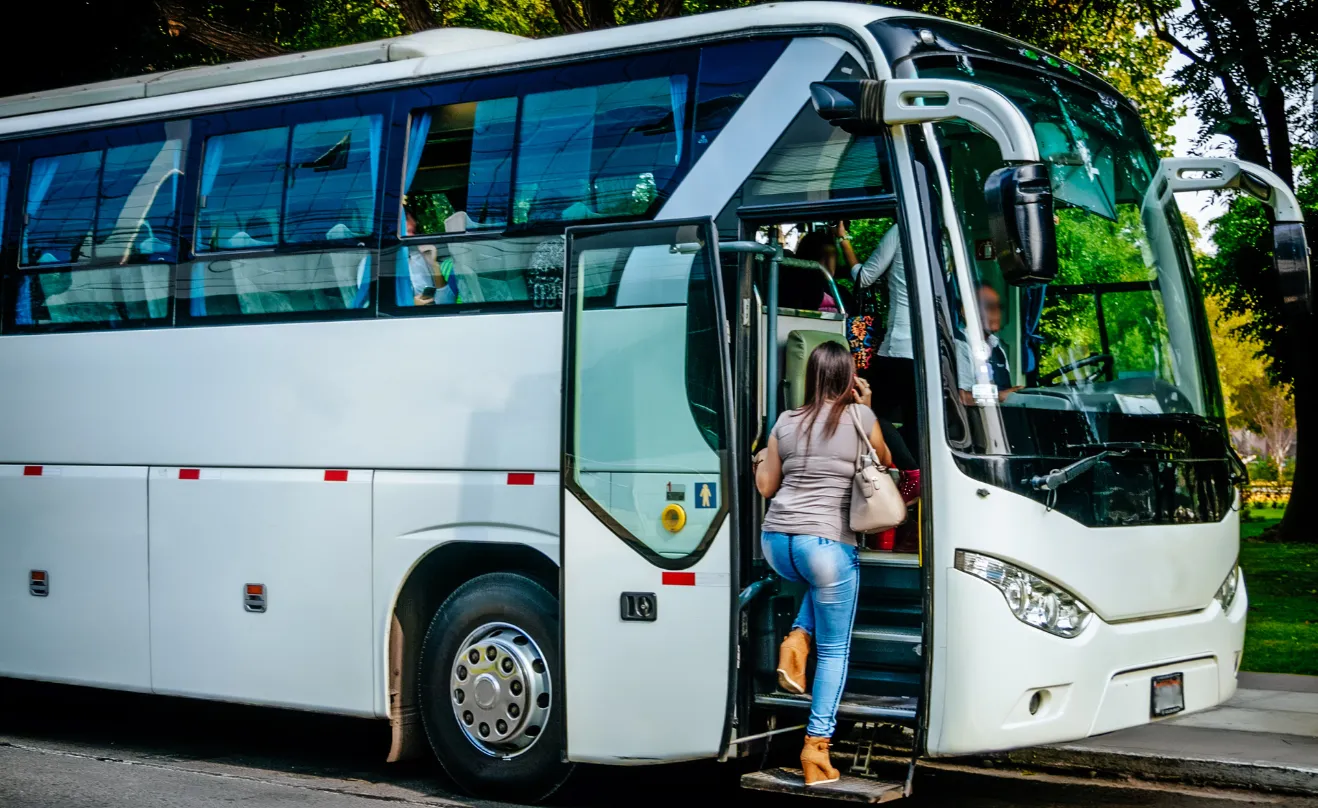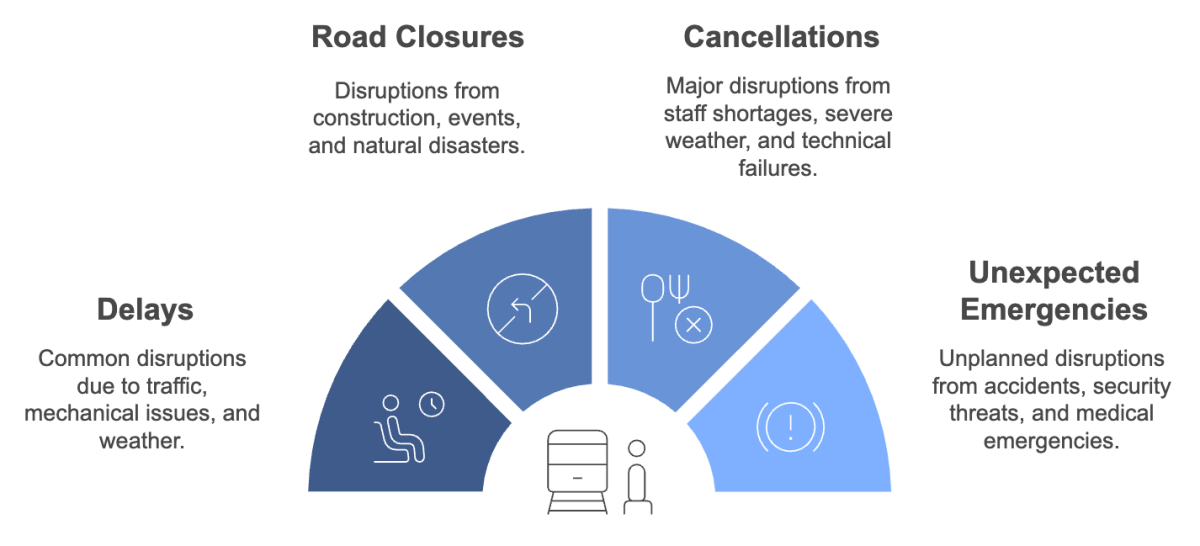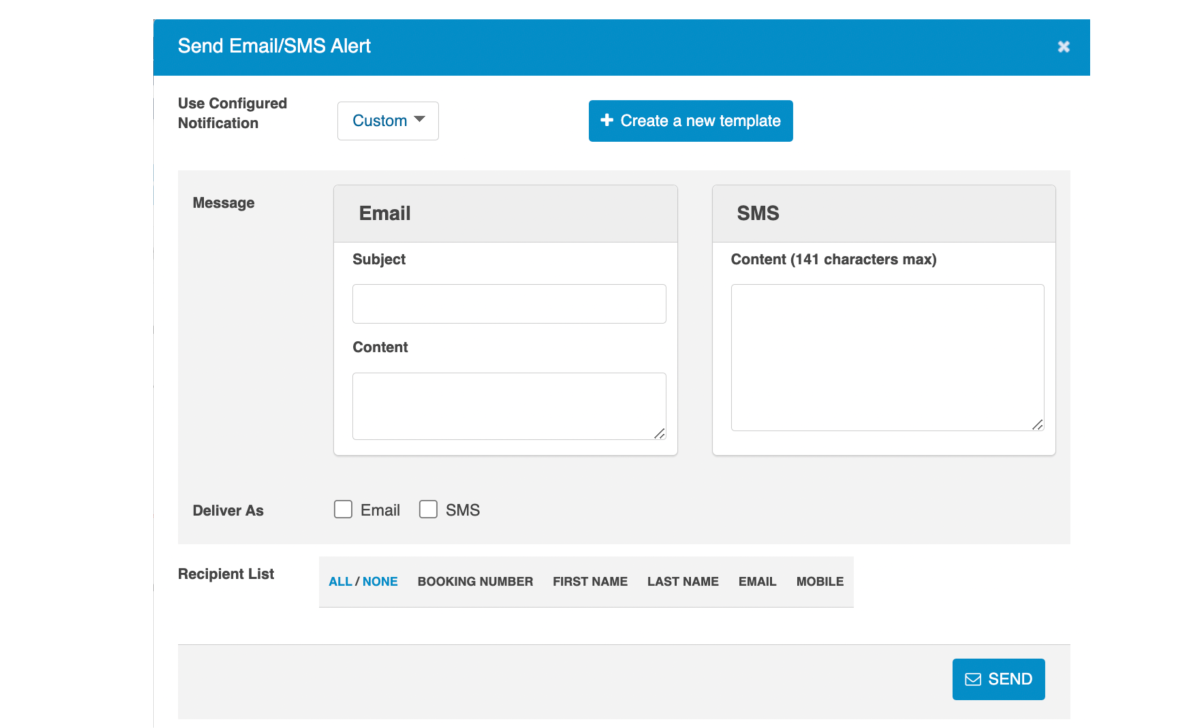Comprehensive Guide to Managing Service Disruptions for Transport Operators

Comprehensive Guide to Managing Service Disruptions for Transport Operators
Service disruptions are an unavoidable reality in the travel and transportation industry. These interruptions, whether caused by unexpected weather changes, technical breakdowns, or route closures, pose significant challenges for both passengers and operators. Passengers face inconvenience, frustration, and uncertainty, while operators must handle operational issues, resource allocation, and potential financial losses.
Effective disruption management is necessary for maintaining passenger trust and ensuring operational efficiency. This guide explores the types of service disruptions, their impact, and how Zaui’s innovative Service disruption feature helps transportation operators handle them seamlessly while prioritizing both operational needs and passenger satisfaction.
What is Service Disruption?
Service disruptions is any event or situation that alters the usual functioning of travel services. They can take many forms, such as delays caused by traffic jams, weather-related cancellations, or route closures due to construction or emergencies.
For operators, disruptions are more than just operational hiccups, they represent a challenge to the customer experience. Disruptions often lead to snowball effects, impacting not just one route or trip but an entire schedule, resulting in a ripple effect of delays, resource mismanagement, and customer dissatisfaction.
The Dual Impact of Service Disruptions
On Passengers
Passengers rely on transportation operators for smooth and timely journeys. Disruptions, when poorly managed, create a negative experience, leading to loss of trust in the operator. Studies consistently highlight the effect disruptions have on passengers:
- Nearly 80% of travelers experience some form of disruption, ranging from minor delays to outright cancellations.
- Business travelers, in particular, face severe consequences, with missed meetings and reduced productivity cited as the most common issues.
- Uninformed passengers are far more likely to leave negative reviews
Effective communication during disruptions is a key driver of passenger satisfaction. When passengers are informed promptly about changes and provided with clear alternatives, their confidence in the operator is restored and the negative feeling caused by the disruption is reduced.
On Operators
The operational side of managing disruptions is complex and often stressful. Operators are tasked with revising schedules, notifying passengers, reallocating resources, and handling refund or rescheduling requests,all while maintaining service quality. Without the right tools, these tasks can become overwhelming, leading to errors and inefficiencies.

Types of Service Disruptions and Their Effects on Transport Operators and Passengers
In-order to handle Service disruptive, it is important the types of Service disruptions so that an operator can be prepared with the right messaging and tools to handle it effectively. Service disruptions in the travel and transportation industry come in various forms, each with unique challenges and impacts on both passengers and operators. Below are the key categories of service disruptions:
1. Delays
Delays are the most common type of disruption and occur when transportation services run behind schedule. They can result from a variety of factors, including:
- Traffic congestion: Urban areas and peak travel times often experience heavy traffic that slows down vehicles.
- Mechanical issues: Vehicle breakdowns or maintenance problems can unexpectedly delay trips.
- Adverse weather conditions: Snowstorms, heavy rain, or fog frequently cause delays by reducing travel speeds and increasing safety risks.
Impact on Passengers:
Delays frustrate passengers, particularly when they are not informed about the cause or duration of the delay. Missed connections, appointments, or flights can result from even minor delays, making timely communication crucial.
Impact on Operators:
For operators, delays disrupt schedules, create a ripple effect on subsequent trips, and require quick action to notify passengers and adjust resources.
2. Road Closures
Route closures occur when specific roads, paths, or areas are temporarily or permanently blocked, preventing vehicles from using their planned routes. These closures may happen due to:
- Construction projects: Long-term roadwork often forces vehicles to reroute.
- Special events: Festivals, parades, or sports events can result in temporary closures.
- Natural disasters: Landslides, floods, or fallen trees may render certain routes unusable.
Impact on Passengers:
Route closures can disrupt an entire travel plan, especially when passengers rely on access to specific stops or destinations. The absence of timely rerouting information exacerbates passenger dissatisfaction.
Impact on Operators:
Operators face challenges rerouting vehicles, managing delayed schedules, and dealing with cancellations or refund requests.
3. Cancellations
Cancellations are the most disruptive type of service interruption. They occur when an entire trip or route is removed from the schedule, typically for reasons such as:
- Staff shortages: Illness, strikes, or unexpected absences may leave operators without enough personnel to run scheduled services.
- Severe weather: Snowstorms, hurricanes, or other extreme conditions can make it unsafe to operate vehicles.
- Technical failures: System malfunctions or breakdowns may render vehicles inoperable.
Impact on Passengers:
Passengers are significantly inconvenienced by cancellations, particularly if alternative transportation options are limited. Without clear communication or compensation, cancellations can lead to long-term damage to customer relationships.
Impact on Operators:
Cancellations require operators to handle a large volume of refunds or rescheduling requests, often straining resources and increasing operational costs.
4. Unexpected Emergencies
Emergencies are unplanned events that disrupt normal operations. These may include:
- Accidents: Collisions involving vehicles on the route can cause sudden delays or closures.
- Security threats: Situations like bomb scares or terrorism-related incidents can lead to immediate suspensions of service.
- Medical emergencies: Onboard incidents involving passengers may force unscheduled stops or delays.
Impact on Passengers:
Emergencies create uncertainty and fear, especially if passengers are not informed promptly about what is happening and how it will be resolved.
Impact on Operators:
Operators must respond quickly, ensuring passenger safety while managing operational challenges, such as rerouting or delay handling.

The Growing Challenge of Service Disruptions and How to Stay Ready
Before we get to the operational challenges. It is important to note why how it is affecting the overall travel industry. Travel disruptions are becoming more frequent due to factors such as climate change, infrastructure challenges, and global events. Operators must adapt to these realities by investing in tools that prioritize efficiency and customer satisfaction.
Recent studies highlight key trends in the industry:
- Climate change is leading to more extreme weather events, causing delays and cancellations.
- Modern passengers expect real-time updates and flexible options during disruptions.
- Integration with external systems, such as dispatch and booking platforms, is increasingly important for managing disruptions effectively.
Operational Challenges Faced by Transport Operators During Service Disruptions
Service disruptions in the tours and transportation industry create significant challenges for operators, often requiring immediate and coordinated action to minimize their impact. The complexity of these disruptions lies in their unpredictability and the multiple layers of response required to ensure smooth operations while maintaining passenger trust. Below, we explore the key operational challenges faced by operators during such situations:
1. Real-Time Communication with Passengers
One of the most critical aspects of disruption management is keeping passengers informed about changes to their journey. Passengers expect real-time updates regarding delays, cancellations, or route changes. However, many operators struggle with:
- Outdated communication systems: Manually notifying passengers about disruptions can be time-consuming and error-prone.
- Inconsistent messaging: Without a centralized system, information may reach passengers inconsistently, leading to confusion and frustration.
- Last-minute bookings: Managing communications for passengers who book just before or during disruptions adds another layer of complexity.
Without efficient communication tools, operators risk leaving passengers uninformed or providing conflicting information, which can damage their reputation.
2. Updating Schedules and Routes
Disruptions often require immediate changes to schedules or routes. Operators face several challenges when managing these adjustments:
- Domino effects: A single delay can disrupt multiple subsequent trips, requiring operators to reschedule entire route networks.
- Manual adjustments: For operators relying on traditional systems, updating schedules or reassigning stops is a labor-intensive process prone to errors.
- Coordination across teams: Ensuring that drivers, dispatchers, and support teams are aligned with the new schedule is essential but difficult to achieve under pressure.
Efficient tools are needed to streamline these adjustments, allowing operators to make quick changes without disrupting other services.
3. Managing Refunds and Rescheduling Requests
Cancellations and route closures often trigger a wave of refund or rescheduling requests. Handling these demands is one of the most resource-intensive tasks during a disruption. Operators frequently struggle with:
- High volumes of requests: Disruptions can lead to a sudden influx of passengers seeking refunds, credits, or alternative bookings.
- Complex policies: Navigating various refund policies and ensuring compliance with regulations adds to the administrative burden.
- Manual processing: Without automated systems, processing refunds or rescheduling requests involves significant manual effort, leading to delays and potential errors.
Operators need streamlined processes to manage these requests efficiently while ensuring passengers receive timely and fair resolutions.
4. Reallocating Resources
Disruptions often require the reallocation of vehicles, staff, and other resources. For example, a route closure might necessitate deploying additional vehicles on alternate routes or reassigning drivers. Challenges in resource management include:
- Limited visibility: Operators may lack real-time data on the availability of vehicles, drivers, and other assets.
- Conflicting priorities: Balancing the immediate needs of disrupted routes with ongoing operations can lead to operational bottlenecks.
- Underutilization or overutilization: Poor resource allocation can result in underused assets on unaffected routes or overstressed resources on alternate routes.
Efficient resource management tools are essential to optimize the use of assets during disruptions while minimizing operational inefficiencies.
5. Dealing with Passenger Dissatisfaction
Service disruptions often leave passengers feeling frustrated, particularly if they are left uninformed or perceive the operator as unprepared. Operators face significant challenges in managing passenger expectations and addressing complaints, including:
- Negative reviews and feedback: Dissatisfied passengers are more likely to leave negative reviews, which can impact the operator’s reputation.
- Customer support overload: Disruptions lead to increased queries and complaints, overwhelming customer support teams.
- Rebuilding trust: Once passengers lose trust due to poor disruption management, regaining their loyalty becomes a long-term challenge.
Effective communication and management strategies are critical to mitigating dissatisfaction and maintaining passenger trust.
6. Adhering to Regulatory Requirements
In many regions, transportation operators must comply with strict regulations regarding refunds, passenger rights, and safety standards during disruptions. Challenges include:
- Complex legal frameworks: Navigating local, national, or international regulations during disruptions can be daunting.
- Ensuring compliance under pressure: Operators must make quick decisions that align with regulatory requirements, even in high-pressure situations.
- Penalties for non-compliance: Failure to meet legal obligations can result in fines, lawsuits, or loss of operating licenses.
Operators need clear processes and tools that ensure compliance while minimizing delays in response.
7. Maintaining Staff Morale and Efficiency
Service disruptions can take a toll on staff, particularly frontline employees who face the brunt of passenger frustration. Challenges in this area include:
- Increased workload: Staff may need to work overtime or handle multiple tasks, such as rerouting passengers or addressing complaints.
- Emotional stress: Dealing with upset passengers and high-pressure situations can lead to burnout.
- Coordination issues: Poor communication between teams can exacerbate stress and reduce efficiency.
8. Balancing Short-Term Responses with Long-Term Planning
While the immediate focus during a disruption is on minimizing its impact, operators also need to consider the long term implications. Challenges in balancing short term and long term priorities include:
- Impact on Resource Allocation: Focusing on short term fixes can deplete resources needed for ongoing operations or future planning.
- Lack of post-event analysis: Many operators fail to analyze disruptions to identify patterns or improve future responses.
- Passenger loyalty: Poor handling of a single disruption can have long-term effects on brand loyalty and customer retention.
Handling Service Disruptions Effectively with Zaui
Zaui’s Service Disruptions feature is specifically designed to address the challenges faced by transportation operators. This powerful tool simplifies the process of managing delays, closures, and cancellations, ensuring passengers are informed and operators are equipped to handle disruptions with minimal stress.
At its core, the feature allows operators to:
- Update schedules in real time to reflect changes caused by delays or closures.
- Notify passengers instantly through email or SMS, keeping them informed and reassured.
- Simplify refund and credit processes, offering passengers flexible solutions to adjust their plans.
The result? A seamless approach to managing disruptions that benefits both operators and passengers.
Managing Common Disruption Scenarios with Zaui
Delays are among the most frequent disruptions in transportation. Whether caused by traffic jams, vehicle breakdowns, or weather, they disrupt passenger plans and create logistical headaches for operators. Zaui simplifies delay management by enabling operators to log the delay directly into the system, updating schedules and notifying passengers instantly.
For example, if a bus route is delayed by 30 minutes due to traffic, the operator can input the updated timing into Zaui, triggering notifications to all booked passengers. Additionally, the system ensures new bookings reflect the delay, avoiding confusion for last-minute travellers.
Here’s how it works:

1. Time Delays
No one wants to be stuck at their stop, waiting on a late bus. Unplanned disruptions, such as traffic congestion, accidents, detours or vehicle breakdowns happen daily and are out of your control.
🚌How Service Disruption can help: Applying a disruption is simple. Upon receiving notice of delay, your operations team can apply a disruption to a single stop location/or range of locations with the estimated delay time, which will effectively push back the trip’s arrival time. Operators are able to notify impacted guests of the latest changes by email and/or SMS*.
For travellers making a last-minute booking, the delay, and updated times are reflected throughout the booking process to ensure awareness.
2. Route or Stop Closures
Unplanned occurrences like traffic rerouting, construction, events, and natural disasters can result in certain stop locations to be blocked and no longer accessible.
🚌How Service Disruption can help: Operators are able to apply a disruption and close a location or a range of locations along the route. When closed, guests are notified by email and/or SMS and the booking is cancelled.
Affected stops are not bookable online or internally for the duration of the disruption.
Issuing cancellations and payments: With stop or route closures, transportation operators are able to address cancellations simply by moving the payment over to customer credit to be applied towards future bookings. Depending on your policy, once the payment is moved to customer credit – travellers can either request a refund or use the credit to rebook at a later date.
In short, the new feature helps transportation operators:
✅Keep booked passengers informed on trip status, delays, and closures
✅Minimize inconvenience, frustration, and dissatisfaction in the passenger journey
✅Help passengers adjust their travel behaviour and plans
✅Enable your operations team to easily manage and communicate disruptions, and issue necessary refunds or credit for cancelled trips
How Zaui’s Customer 'Fairview Limousine' Handled Service Disruption
Fairview Limousine faced a major road closure due to a festival, disrupting service along a key route. Using Zaui’s Service Disruptions feature, the operator marked the affected stops as unavailable, sent notifications to all impacted passengers, and processed refunds seamlessly. Passengers appreciated the clear communication and hassle-free resolution, leading to positive reviews despite the disruption.
Another operator experienced significant delays due to a vehicle breakdown during peak hours. Zaui enabled the team to update schedules instantly and notify passengers of the revised timings. This proactive approach not only reduced complaints but also ensured passengers could make alternative plans.

Proactive Disruption Management with Zaui Platform
Disruption management isn’t just about reacting to problems as they occur; it’s about being prepared. Zaui enables operators to take a proactive approach by:
- Using historical data to identify routes and times prone to disruptions.
- Preconfiguring the system to respond quickly to anticipated issues.
- Communicating with passengers early to set realistic expectations.
For example, an operator might analyze past data to determine that a particular route is frequently delayed during winter months due to snow. By preconfiguring Zaui to handle these delays, the operator can respond swiftly when disruptions occur.

Preparing for the Future of Disruption Management
As travel and transportation continue to evolve, disruption management will remain a critical focus area. Zaui is at the forefront of this transformation, offering features that future-proof operations and enhance passenger trust.
Looking ahead, operators can leverage Zaui to:
- Use predictive analytics to anticipate disruptions before they occur.
- Personalize passenger communication based on preferences and behavior.
- Integrate with external systems for a unified approach to scheduling, booking, and communication.
Final Word: Turning Challenges into Opportunities
Service disruptions may be inevitable, but they don’t have to compromise passenger satisfaction or operational efficiency. With Zaui’s Service Disruptions feature, operators can manage delays, closures, and cancellations with confidence, ensuring passengers remain informed and supported.
By automating key processes, enhancing communication, and prioritizing the passenger experience, Zaui empowers transportation operators to navigate disruptions effectively. The result? Stronger customer relationships, improved operational resilience, and a competitive edge in a challenging industry.
Connect with our experts and discover how you can take advantage of Zaui's powerful features!
Related Posts

What to Look for in a Travel Booking Software in 2025
Discover the essential features to consider when selecting a travel booking software in 2025 to streamline your travel booking process and enhance customer experience.

How to Start a Tour Business in 2025: Practical Guide
Starting a tourism business is an exciting journey into a landscape full of potential. Travellers are always looking for new adventures, and there is no shortage of niches to explore in the tourism industry. The question is: how do you carve out your place in this vibrant sector?

Turn Clicks into Bookings: Discover the New Zaui Web Checkout - The Ultimate Online Booking Engine
Discover the new Zaui Web Checkout, the ultimate online booking engine that helps you turn clicks into bookings seamlessly. Learn more about how this powerful tool can enhance your online booking experience.


Frequently Asked Questions
No. Zaui’s pricing is fully pay-as-you-go. You aren’t locked into any long-term contract. In fact, leading platforms emphasize this flexibility. Similarly, Zaui lets you start and stop anytime. You can change or cancel your plan freely, so you only pay for what you use.
Absolutely not. Zaui’s pricing is 100% transparent. We disclose all fees up front with no surprise add-ons or “sneak-in” charges. In fact, Zaui’s plans include all core features “without additional fees”. Industry experts note that hidden fees undermine trust so we avoid them entirely. All costs are clearly outlined in our pricing, and there are no extra setup charges or undisclosed surcharges at checkout.
Zaui integrates with major payment gateways (e.g. Stripe) so you only pay standard credit-card processing rates (roughly 1.9%+$0.30/transaction) and we don’t mark them up. Only the published platform commission is added on bookings. You also have full control over who pays the commission, we let you decide whether to absorb booking fees or pass them on to customers. In short, you’ll only pay the transparent booking commission and normal gateway fees, nothing extra.
Your onboarding and support are included in the price. We provide white-glove setup help and ongoing 24/7 support at no additional cost. Our dedicated customer-success team will guide you through every step, ensuring a smooth launch. You won’t pay extra for training or service other than the onboarding fee; it's all built into your plan.
You can schedule a free demo with our team. Our Zaui ninjas will walk you through pe how Zaui can work for your business and highlight opportunities to grow with our advanced features all without any upfront payment. This way, you can feel confident it’s the right fit before making a commitment.
Of course. Zaui’s plans are fully flexible. You can upgrade or downgrade at any time to match your needs, without penalties. You can move to a higher tier or back down easily, and your billing adjusts automatically.
No. Zaui does not charge its commission on offline/manual bookings. “No fees on offline bookings” You only pay the commission when a booking is processed online through our system. Manual reservations (or bookings from partner channels we set up for you) incur no extra platform fee. (30% or less)
All of Zaui’s core features are included in your plan at no extra charge. We believe in value and transparency: Zaui provides over 15 advanced features (Google Things to do, reporting tools, marketing tools, reports, etc.) at no additional cost. Many competitors charge extra or require higher plans for the same features, but with Zaui you get the full suite of tools in one package. Any optional add-ons (if any) will always be clearly listed and optional there are no surprise paid upgrades for standard features.
Each Zaui plan is designed for clarity and fairness, following industry best practices. You can trust that our pricing is transparent and flexible, with the support you need built in.
Extra accounts- unlimited agents, resellers, user



